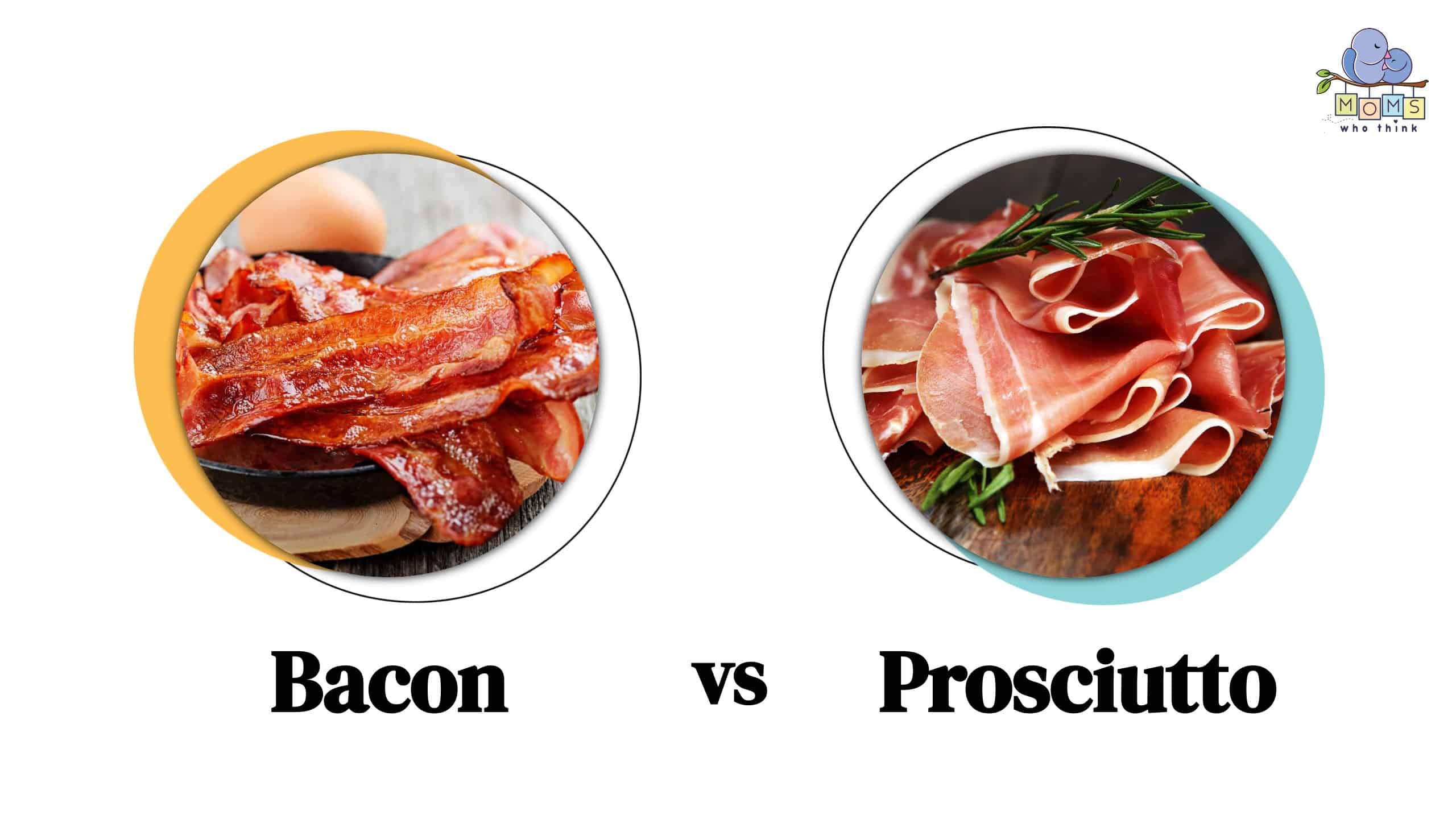You may see prosciutto and mistake it for bacon, and you may even think it tastes somewhat similar. However, though they do have some slight similarities, the battle of prosciutto vs. bacon actually provides many differences, including how they are prepared, their flavor, how they’re served, and more.
Let's explore how each of these foods are created, their taste differences, and compare their nutritional differences.
Prosciutto vs. Bacon: What is the Difference?
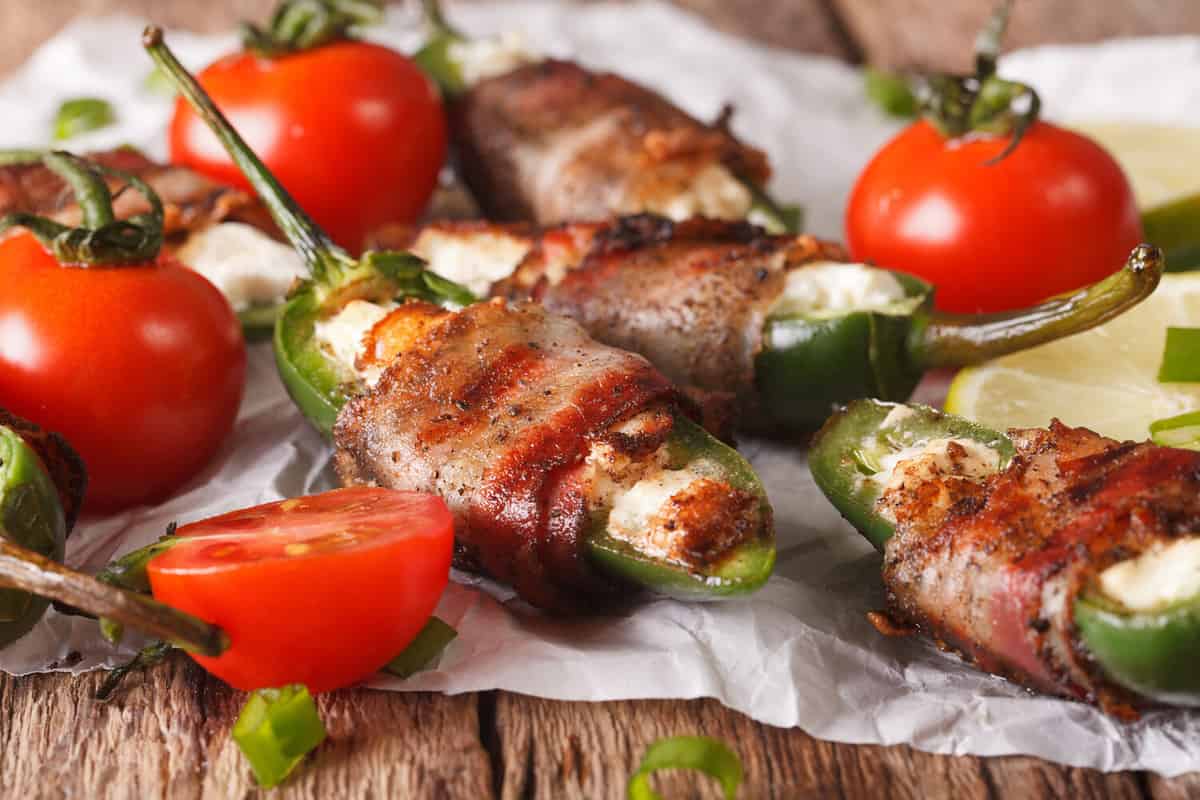
Bacon is often wrapped on appetizers
©AS Foodstudio/Shutterstock.com
The most important difference between bacon and prosciutto is the taste. Bacon is smoky and crispy while prosciutto is sweeter and more delicate. This difference comes from bacon usually being eaten cooked whereas prosciutto is typically consumed raw after extensive curing that usually lasts 1 to 2 years.
Other key differences include bacon being popular in American cuisine whereas prosciutto originated in Italy. Finally, bacon comes from the belly of the pig while prosciutto is made from the hind leg or thigh of the pig.
- The must-have convenient reference guide for every home cook!
- Includes more than 8,000 substitutions for ingredients, cookware, and techniques.
- Save time and money on by avoiding trips to grab that "missing" ingredient you don't really need.
Below are more details on the most glaring and unique characteristics of each.
Appearance and Taste
Bacon is smoked using many different types of wood, and they give each cut a different flavor, like the example of applewood bacon. In contrast, prosciutto is prepared using a more strict method, so there aren’t as many variants. In most cases, prosciutto has a sweet and salty taste with a buttery texture.
The appearance of both products can also be quite different. After it’s prepared, prosciutto has a salmon pink color, and it is almost always cut into paper-thin slices. Each slice has a streak of fat. Alternatively, after bacon is smoked and prepared, it typically has a deeper pink color with a golden rind, and it may be cut thinly or in thicker pieces.
Difference In Preparation
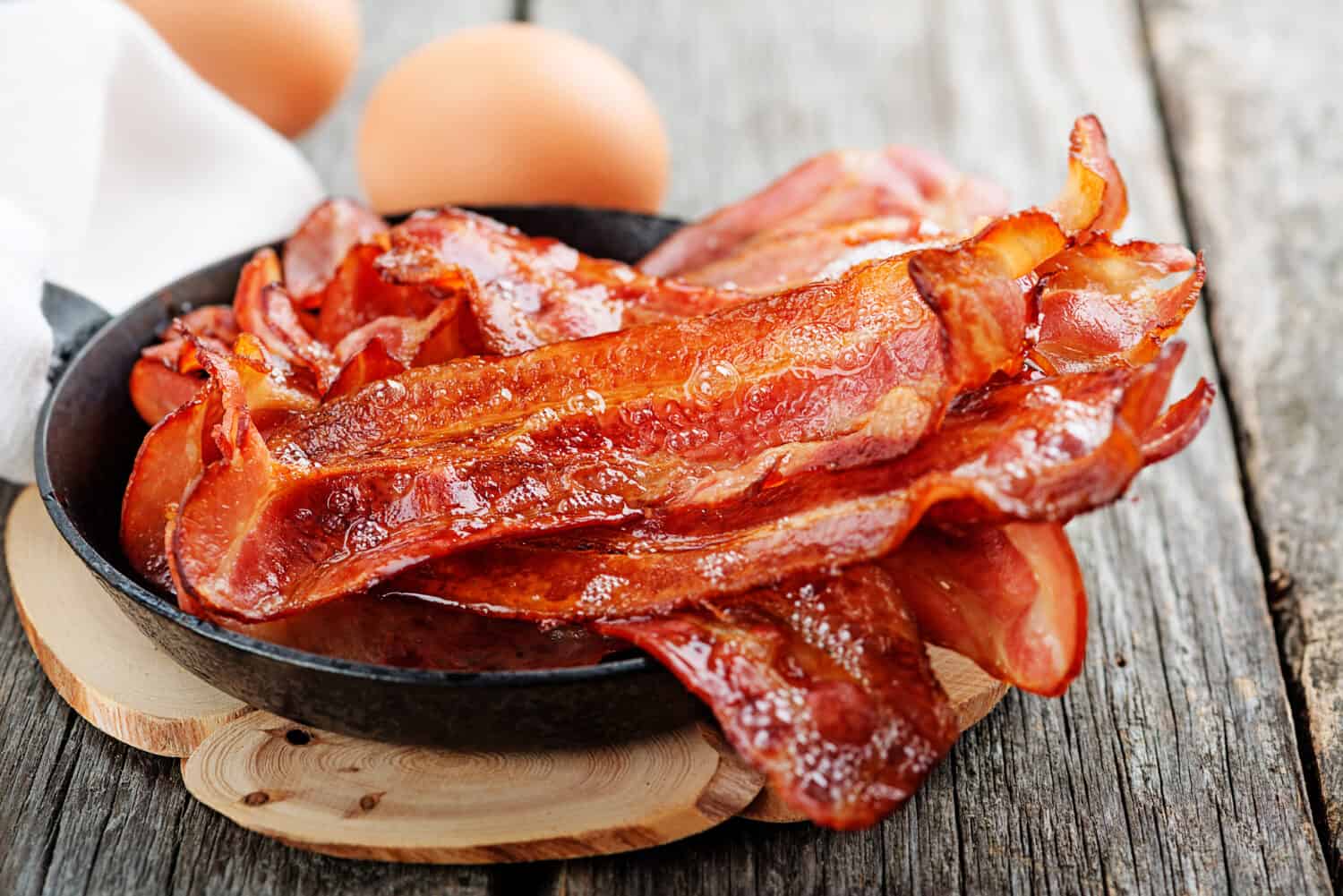
Before bacon hits your skillet, it goes through an extensive process.
©nelea33/Shutterstock.com
One of the most significant differences in the discussion of prosciutto vs. bacon is how both meats are prepared. Here is a step-by-step process for each so you can see the differences.
How Prosciutto is Prepared
Preparing prosciutto starts by taking the meat from the pig’s hind leg and then curing and cooking it for a full year by:
- Heavily salting the meat and then refrigerating it for a week.
- Then the meat is taken out and salted once more before being hung in a refrigerator again for two to three months. The purpose of this is to allow the salt to absorb thoroughly into the meat.
- The prosciutto is taken out of the refrigerator and washed to remove the salt. It is again hung for a few more days before the meat is softened with pepper, salt, and a lard mixture that keeps it from drying out.
- It is again hung up for three months, this time at room temperature, so it can begin to dry and harden.
- Next, it’s moved to a space that has less air and light so it can cure completely. It’s typically left there for nine months to three years. The time can vary, but by law, it must be hung for at least 400 days.
How Bacon is Prepared
The process of preparing bacon is much more simple, but it still needs some care. Bacon is first taken from the pig’s belly.
- The meat is then dry-cured with a seasoning of sodium, salt, nitrates, and occasionally sugar.
- The meat is left to hang for one to two weeks before it’s rinsed off.
- Next, a smoker is used to provide extra flavor. Then, the meat is left to air dry for between three weeks to several months.
- Then, the bacon is given extra flavor with curing ingredients, like salt, sugar, and various seasonings.
- Finally, the meat is cold-smoked.
Prosciutto vs. Bacon Nutritional Comparison: Calories, Fat, and More
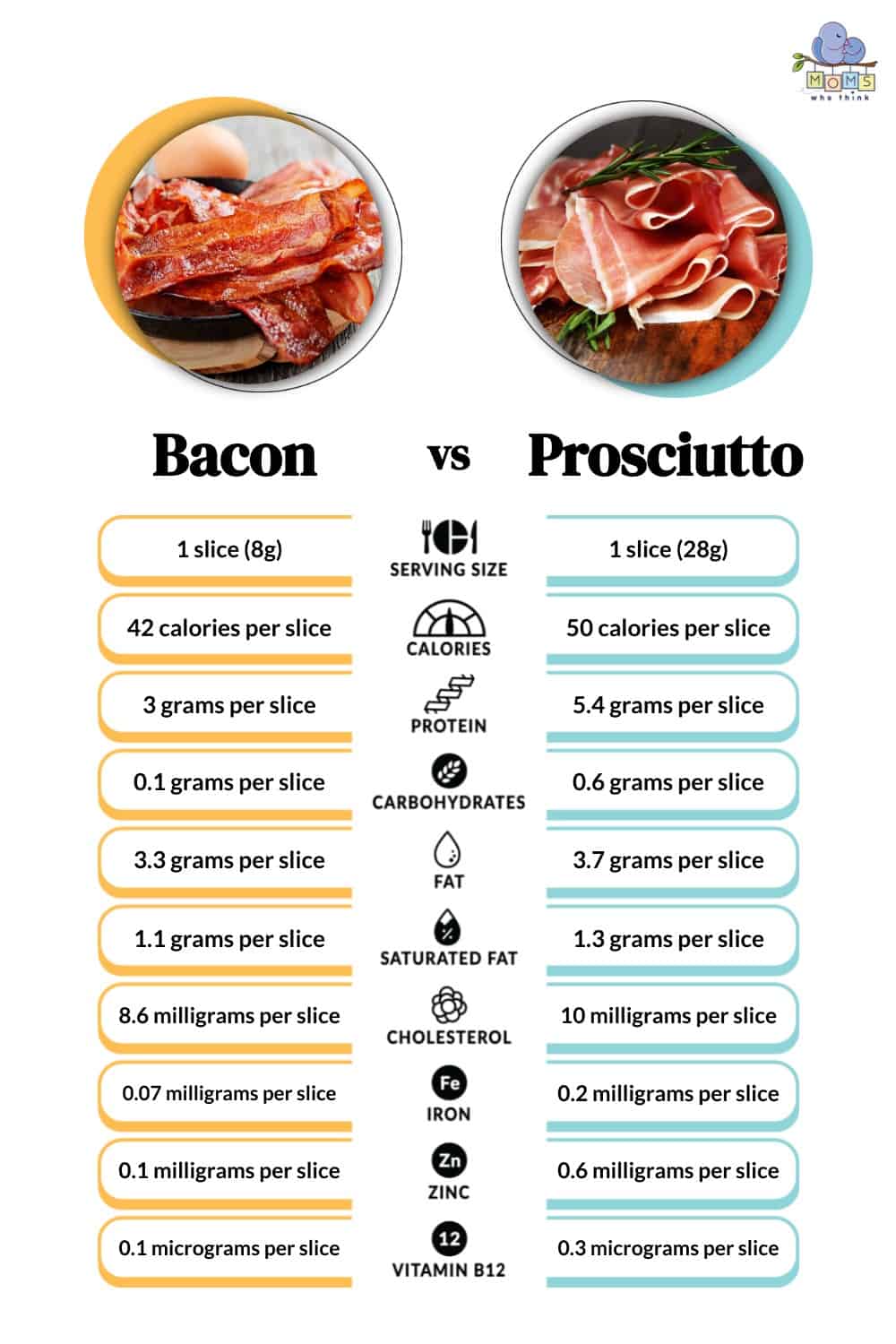
Data from the USDA
©
If you’re looking for the healthiest possible health option, then neither prosciutto nor bacon is the best option because they both contain a lot of salt. Bacon contains the most salt. One slice (which is only 8 grams) contains about 137 milligrams of sodium, which makes up about 5% of your daily allowance. Eat too much bacon on a daily basis, and you could start to experience health problems, including high blood pressure, stroke, and heart disease.
By comparison, prosciutto contains less salt, but it’s by no means considered a healthy option. One cup (140 grams) will contain about 70% of daily sodium.
Prosciutto vs. Bacon: Similarities
Although they have a fair share of differences, there are some similarities in the discussion of prosciutto vs. bacon. Among them is that both are cuts of pork that are taken from pigs. They both also undergo a dry-curing preparation process that uses salt as a preservative to give each meat its taste.
It’s true both products have different appearances, and an experienced individual would likely be able to point out one or the other without much effort. With that said, both can tend to look similar, which often makes them often interchangeable in many of the same dishes. In many cases, the casual diner might not be able to tell the difference when bacon or prosciutto is cooked into a meal.
Best Substitutes for Bacon
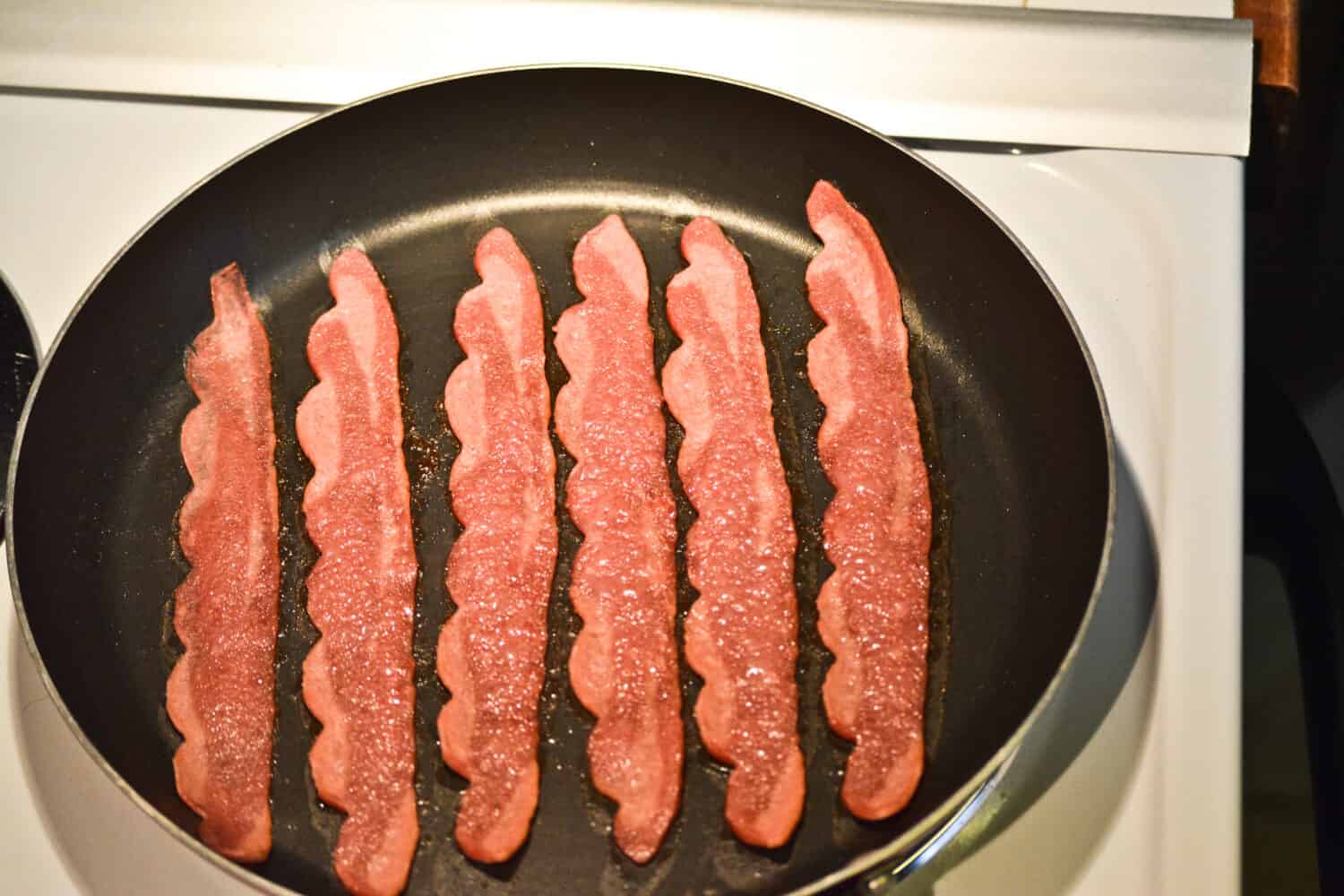
Turkey Bacon is a tasty alternative to traditional bacon.
©Pearl Williamson/Shutterstock.com
If you enjoy the taste of bacon as much as the next person, but you want to try something new but similar, then you’re in luck because there are many alternatives to consider. These are both vegan and non-vegan options.
Beef Bacon
Beef is always a popular option, and it can often have a similar texture to bacon. Also, like bacon, you shouldn’t eat beef in large quantities as it can be unhealthy. Beef is a leaner option, and it’s very tasty.
Pancetta
This is the Italian version of bacon, and so it has many similarities, including the texture and taste. It is made from salt-cured pork belly, but it’s cured and not smoked. It also goes well as a substitute in your recipes.
Turkey Bacon
You’ve probably known someone that prefers turkey bacon instead of standard bacon because it is a healthy alternative and also tastes great at breakfast. This is a white meat that is cured and smoked, so it has a similar taste.
- The must-have convenient reference guide for every home cook!
- Includes more than 8,000 substitutions for ingredients, cookware, and techniques.
- Save time and money on by avoiding trips to grab that "missing" ingredient you don't really need.
Duck Bacon
Yes, bacon can come from ducks too. In this case, it comes from the breast of a duck, so it’s not as fatty as bacon. It’s typically cut thicker, so you won’t have the same crunch if that’s important.
Salmon Rashers
No, it won’t taste quite like bacon, but if you’re looking for something to fill the place of bacon, then it will work. This is made from salmon, so keep that in mind. However, rashers have a similar crisp.
Salt Pork
This type of pork comes from the lower portion of the pork belly, so it does come with some fat. It’s also saltier. However, its flavor is very rich, and it works well as a topping for chowders and on bean and veggie dishes.
Guanciale
Guanciale is made from pork cheek, and while it doesn’t taste exactly like bacon, it’s a great substitute. It is a fattier option that has a buttery taste that makes it great on sandwiches.
Bacon recipes
If you’re on the bacon end of the prosciutto vs. bacon argument, you’ll be happy to hear that there are various recipes that are elevated with a bit of this classic meat. Here are some of our favorites:
Print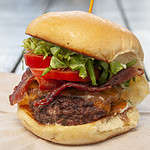
Southwest Bacon Burgers
- Yield: Serves 4
Ingredients
1 (1 pound) package ground sirloin patties (4 patties)
2 teaspoons salt-free southwest sweet and spicy seasoning
¼ cup nonfat mayonnaise
¼ cup chunky salsa
2 tablespoons bacon bits
4 lettuce leaves
4 (2 ounce) hamburger buns with sesame seeds
4 thin slices sweet onion
4 slices tomato
Instructions
1. Rub both sides of sirloin patties with barbecue rub.
2. Place patties on grill over medium-hot coals; grill, covered, 6 minutes on each side or until done.
3. While meat cooks, combine mayonnaise, salsa, and bacon bits.
4. Place lettuce leaves on bottom halves of buns; place patties on lettuce. Top with onion, tomato, 2 tablespoons mayonnaise mixture, and remaining bun halves.
Nutrition
- Serving Size: Per serving
- Calories: 402
- Sodium: 541mg
- Fat: 12g
- Saturated Fat: 4g
- Carbohydrates: 39g
- Fiber: 2g
- Protein: 33g
- Cholesterol: 100mg
- Bacon Rigatoni and Asparagus – Bacon is the star of this tasty pasta dish.
- Bacon, Spinach, and Cheese Quiche – A classic quiche made better with bacon.
- Bacon Cheese Loaded Grilled Potatoes – Cheese, potatoes, and bacon make the perfect combination.
- Bacon Tomato Pasta – A tasty tomato-inspired pasta improved by bacon.
Prosciutto Recipes
If you instead prefer the flavors of prosciutto when you think of prosciutto vs. bacon, then try some of these tasty recipes.
- Cheese Stuffed Chicken Breasts – This prosciutto dish is tasty and healthy.
- Roasted Cod with Prosciutto and Fresh Sage – Cod is always made better with the inclusion of Prosciutto.
- Charcuterie Board – Add prosciutto to your board, and your guests will thank you.
- Savory Creamy Ham Fettuccine – This pasta benefits from a healthy dose of prosciutto.
Conclusion
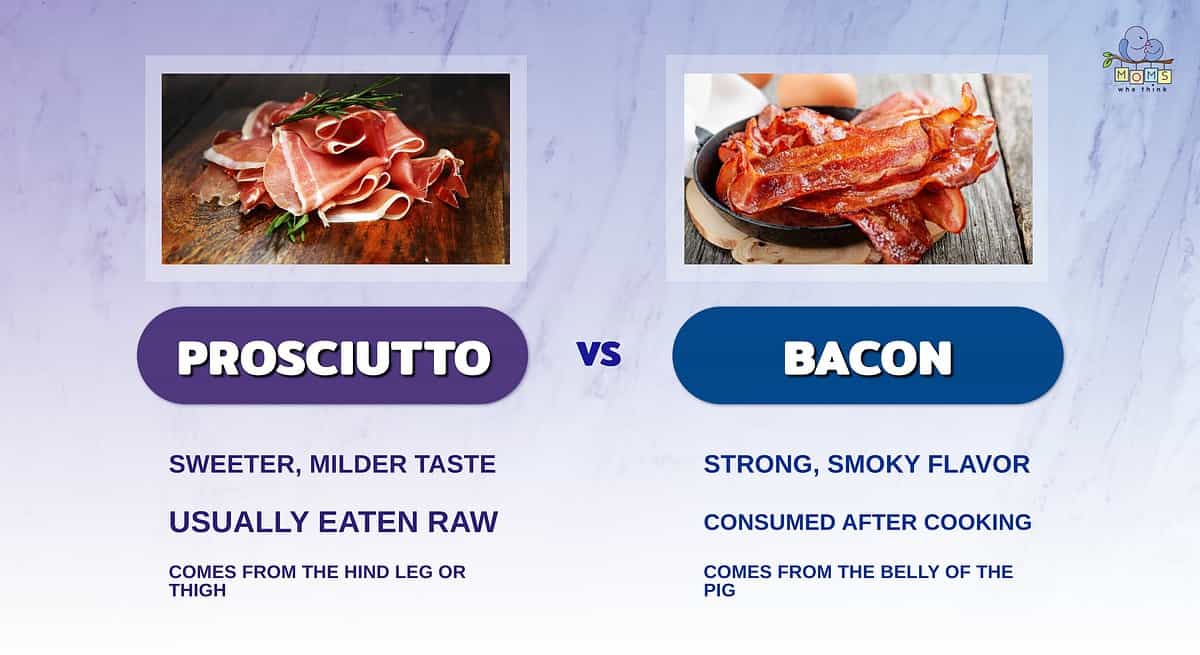
- Since bacon is cooked prior to consumption, it has a strong and smoky flavor. This contrasts the mild sweetness of prosciutto.
- Prosciutto is generally eaten raw. Don't let this scare you- the meat is cured for one to two years prior to sale, making it perfectly safe to eat.
- Bacon comes from the belly of the pig, while prosciutto is sourced from the hind leg or thigh of the pig.
As you can see, there are a variety of differences when it comes to the discussion of prosciutto vs. bacon. While both are delicious and make for great ingredients, their flavors, health profiles, and preparation are very different. Still, don’t hesitate to try either one when you get the chance.
- The must-have convenient reference guide for every home cook!
- Includes more than 8,000 substitutions for ingredients, cookware, and techniques.
- Save time and money on by avoiding trips to grab that "missing" ingredient you don't really need.
